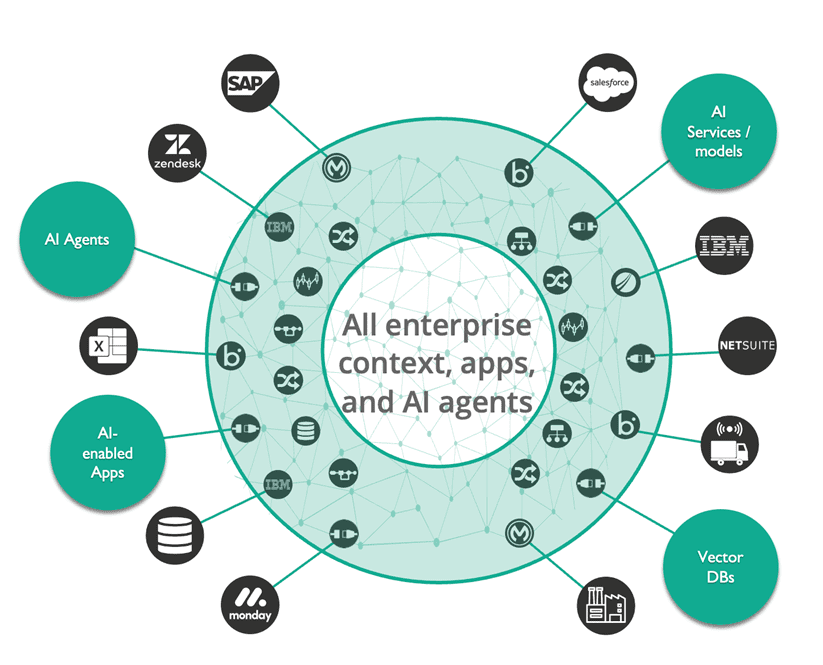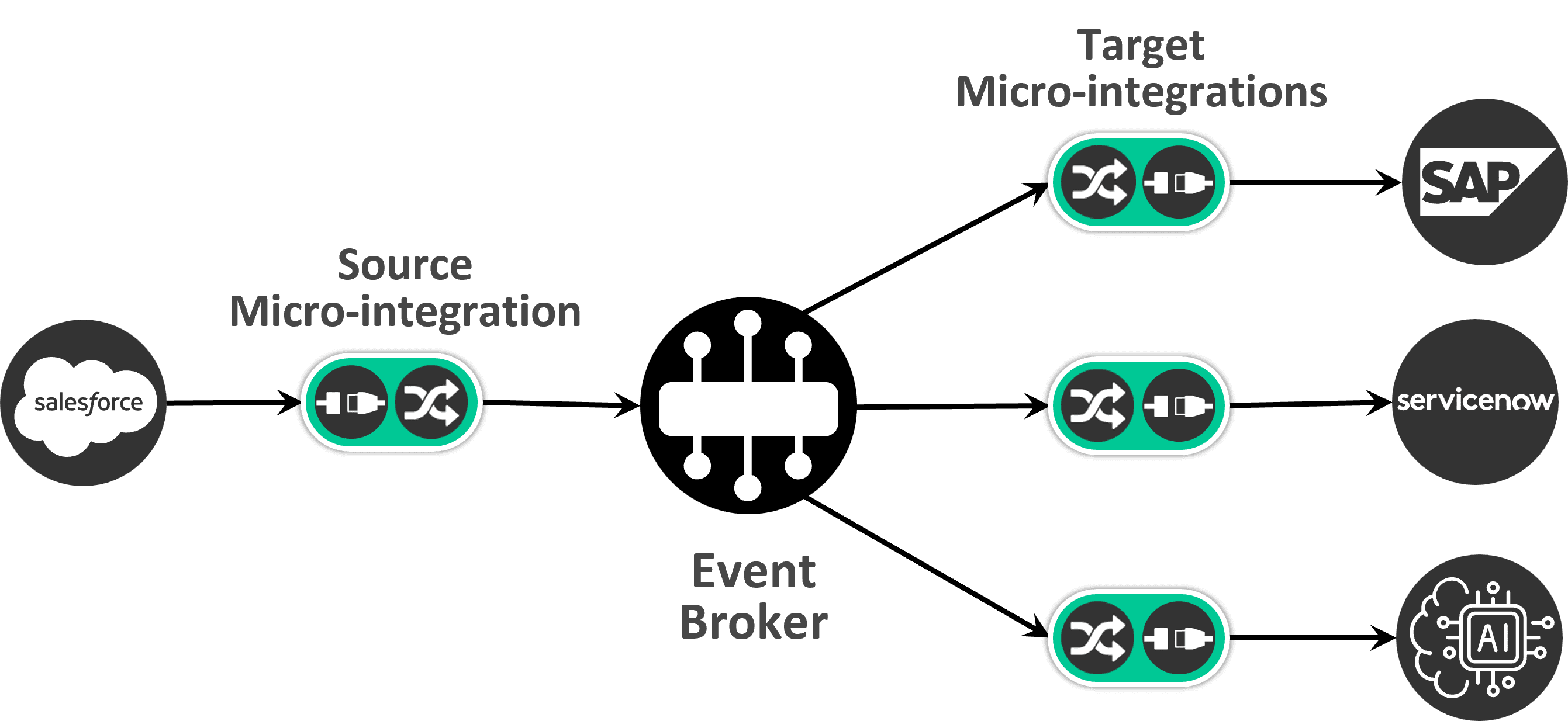Context Mesh: Why you Need EDA to Succeed with AI

The rapid evolution of artificial intelligence (AI) presents enterprises with a complex set of challenges:
- Lack of Real-Time Information: Large language models (LLMs) are growing increasingly sophisticated, so you need the ability to change models over time, and they inherently lack real-time contextual data crucial for enterprise applications. Retrieval-augmented generation (RAG) promises to bridge this gap, but not all RAG databases are updated in real-time as events occur.
- Scalability Concerns: Second, we are in a stage of experimentation and exploration. Some of the promising solutions being developed may work in theory, but might not scale effectively and be production ready for enterprise.
- Distribution Across Environments: Enterprise data is distributed and siloed across many applications and infrastructures—on-premises, edge, and cloud—making hyperscaler solutions that require moving data to their services suboptimal. Moreover, global organizations change – new departments, new applications, new business process, etc. – all of which need a way to feed into the system.
- Ramifications of Agentic AI: Finally, the shift towards agentic AI raises questions about the right architecture to provide AI agents with necessary context and facilitate inter-agent communication.
With this post I’ll introduce a solution called a “context mesh” and explain both how it works and how it can benefit your business by:
Subscribe to Our Blog
Get the latest trends, solutions, and insights into the event-driven future every week.
Thanks for subscribing.
- Accelerating your adoption of AI by more easily integrating it with existing systems.
- Enhancing customer experiences with more timely, personalized data and recommendations.
- Speeding up and derisking decision making by establishing a decision-making ecosystem that responds to changing business conditions and customer needs.
- Cutting costs and increasing operational efficiency by reducing data redundancy and simplifying integration.
- Fostering innovation across your organization by enabling teams to very quickly and cost-effectively develop and deploy AI-driven products and services.
- Future-proofing your AI Initiatives by letting you easily adopt new technologies and adapt to changing business requirements without major overhauls.
You can skip ahead and learn how context mesh enables these benefits below if you like, or read on to learn what a context mesh is and what key enabling capabilities and technologies make one tick.
The Importance of EDA in AI
These challenges call for a solution that enables rapid changes, provides real-time context, scales effectively, and operates seamlessly across diverse environments.
If you are looking to successfully deliver AI projects that rely on real-time information, you need to feed models situational context. Many integration vendors, i.e. providers of iPaaS platforms, have pivoted to frame their offering as enabling technology for AI, and they’re not wrong –but iPaaS or integration technology alone is not enough.
To really take advantage of all that AI has to offer, you need to support your connectivity and integration with a data distribution layer that ensures the real-time distribution of massive amounts of precisely targeted information – you need something I like to call a “context mesh.”
Introducing the Context Mesh
A context mesh is an application of something called an event mesh, which is an interconnected network of event brokers that dynamically routes event-driven information between all kinds of applications and devices across environments and around the world. More on those in a minute. The event mesh becomes a context mesh when you add AI agents to the mix and use it to feed them information that gives them real-time context that helps make them a lot better at their jobs.
A context mesh brings together the entire context of an enterprise, which can serve as the bedrock of sophisticated AI-based applications, from intelligent assistants using GenAI models and complex analytical tools to machine language-based recommendation models and purpose-built AI applications using deep or reinforcement learning.
The critical role event-driven communications play in the future of AI is recognized by key players across the integration space, as evidenced by MuleSoft’s recent announcement about AsyncAPI EDA support for this type of application in their platform.
How a Context Mesh Works
At its core, context meshes operate on the principle of real-time, event-driven data distribution, called event-driven architecture (EDA) and event-driven integration. In this section, I’ll introduce the core functions of event-driven integration and some ways that Solace’s offering is uniquely well suited to building a context mesh.
Event Brokers and Event Mesh
Earlier I touched on two technologies you might or might not be familiar with: event brokers and event mesh. The core of event-driven integration is the event broker, which routes information using the publish/subscribe message exchange pattern, whereby data producers publish information to specific smart topics, and consumers can subscribe to receive the information they need using smart topics.
Applications and devices that want to send or receive information connect to an event broker, which keeps track of the subscriptions that indicate exactly which information each target application wants to receive. In addition to routing information where it’s needed, event brokers serve as an intermediary that can receive information in one protocol and pass it along using any number of other protocols as required by subscribers.

This enables real-time data flow, transformation and processing, ensuring that all connected systems and AI models have access to the most up-to-date, relevant information. The event-driven nature of a context mesh means that data is pushed to subscribers as soon as it’s available, enabling immediate responses to changing conditions, triggering actions, and updating RAG databases.
This event-driven approach eliminates the need for constant polling or batch processing, reduces latency and improves overall system efficiency, usability and scalability. In addition, it delivers on the goal of providing real-time context and experience for the consumers of the GenAI-based applications. And let’s not forget, this isn’t just moving events to the AI models. AI models can enrich and transform the events published by any participants in the Mesh and AI Agents can publish events of their own to be consumed across the organization, and in real-time.
Smart Topics
A smart topic is a hierarchical topic structure that allows consuming applications (in this case intelligent agents) to subscribe and receive all of the information they need, and nothing else, using a series of hierarchical terms and wildcards. There are many benefits of smart topics that you can learn about in our video on the subject.
Thanks to smart topics, a context mesh built with Solace PubSub+ Event Broker acts as a central nervous system for the enterprise, efficiently routing data between publishers and subscribers across cloud, edge and on-premises environments without the publishers and subscribers’ even needing to know where it’s going or coming from.
Dynamic Message Routing
This routing is enabled by a feature called dynamic message routing (DMR), which applies networking principles to event distribution. DMR intelligently routes information where and when it’s needed, and only routes it and only forwards it to brokers that serve applications or AI agents that have subscribed to receive it, reducing cloud egress costs and conserving network resources.
Micro-Integrations
Micro-integrations connect all kinds of applications, SaaS services, AI models, vector databases, data lakes and search services to the mesh, allowing them to publish and consume data when events change or conditions change.

To learn more about the often-amazing intersection of EDA and AI, check out my colleague Ed’s recent blog post: Add Intelligence to Your Event Mesh with AI.
Business Value of a Context Mesh
A context mesh represents a whole new way to leveraging enterprise data and AI capabilities, and offers clear business value in several key areas:
Accelerates AI Adoption
Context mesh enables the rapid integration of AI and data analytics into existing business processes, and allows new enterprise context to be easily integrated and published to the mesh, thereby speeding up transformation initiatives. And since a context mesh allows smart integration between on-premises, edge location, and cloud workloads and services, it increases agility as well as the reusability of existing investment while integrating them with the best of breeds of the cloud providers.
For example, a manufacturer could implement predictive maintenance across its factories by integrating sensor data, historical maintenance records, and real-time production schedules, and using the context mesh to route all the data to cloud providers AI services in real-time.
Improves Customer Experiences
By enabling AI applications to access comprehensive, up to date customer data, a context mesh can facilitate the creation of highly personalized and relevant customer experiences.
For example, a bank could use a context mesh to combine a customer’s transaction history and portfolio with real-time market data, AI-summarized news, social media trends and sentiment analysis to give financial advisors better context so they can create a hyper-personalized experience for their customers. The same feeds could also provide value for the self-serve banking customers who use the bank’s app.
Enables Faster, Better Decisions
By providing real-time contextual data to both human decision makers and AI agents, a context mesh can significantly improve both the quality and speed of decisions.
For human decision-makers, access to up-to-the-minute, comprehensive data is only the first step because in most organizations this is a firehose of information. With AI identifying changes that require attention, decision makers get help with actionable real-time insight to reduce decision making risk that comes from acting on outdated or incomplete information. This real-time insight reduces the risk of decisions being made on outdated or incomplete data, leading to more agile and effective strategic choices.
For example, a retail executive could make inventory decisions with the help of a GenAI-based assistant that has access to real-time sales data, weather patterns, and social media trends, all integrated through the context mesh. For AI agents, real-time data dramatically improves the accuracy and relevance of inferences. By continuously updating their knowledge base with the latest information, AI agents can adapt their responses and recommendations on the fly, leading to more contextually appropriate and timely outputs.
For example, a customer service AI could provide more accurate and helpful responses by instantly incorporating current service status, the latest product updates, and customer interaction history into its decision-making process.
The synergy between human intuition and AI-driven insights, both powered by real-time data from the context mesh, creates a powerful decision-making ecosystem that can rapidly respond to changing business conditions and customer needs.
Reduces Costs and Increases Efficiency
Context mesh streamlines operations by simplifying system integration, reducing data redundancy, and improving resource utilization. This leads to significant cost savings through reduced integration and maintenance costs, improved data quality, faster time-to-market, and more efficient scaling of operations.
For example, a global logistics company could use a context mesh to integrate real-time data from its fleet management system, weather services, AI-summarized news, and customer order system. Doing so would enable them to automate alerting and dynamically optimize routes to improve on-time delivery and reduce ancillary freight costs.
Enables and Accelerates Innovation
A context mesh creates an environment where enterprises can very quickly and cost-effectively develop and deploy AI-driven products and services, (particularly those leveraging generative AI encouraging and facilitating innovation across the organization).
For example, an airline could utilize context mesh to enable a GenAI-powered personalized travel assistant. By integrating customer profiles and preferences, and travel history with current flight and hotel costs, and destination information, the airline could create an advanced GenAI chatbot that offers tailored travel recommendations and handles complex booking scenarios.
A context mesh allows this GenAI application to access and combine diverse data streams in real-time, enabling the airline to rapidly prototype, deploy, and refine this innovative service. This not only enhances the customer experience by providing personalized, context-aware assistance but also improves operational efficiency by automating complex travel planning tasks. Additionally, it creates an opportunity to create hyper-personalized travel packages and perhaps sell flights and hotels that are under-utilized.
Future-Proofs AI Initiatives
The flexible, scalable nature of context mesh allows enterprises to easily adopt new technologies and adapt to changing business requirements without major overhauls. Example: An insurance company implements context mesh as part of its digital transformation. When a new AI-powered risk assessment model becomes available, they can easily integrate it into their existing systems through the context mesh’s event-driven integration and immediately enhance their process without any other parts of the system being impacted or needing to know about this AI model change.
Conclusion
As you can see, a context mesh can offer business value and competitive differentiation in the AI-driven economy. It’s the application of a well-established event-driven architecture model called an event mesh to get real time data/context into AI agents and models. This provides a unified, real-time context for AI applications, addresses critical challenges faced by businesses, and offers clear value in the areas of innovation and time-to-market, costs and efficiency, and maintaining competitive advantage over time.
For executives and technical leaders looking to drive their organizations forward in the AI era while maintaining the current investments across their application (and middleware) landscape, context mesh offers a strategic approach to harness the full potential of current enterprise context, AI and real-time data.
Ready to transform your AI initiatives with the power of event-driven integration?
Book a quick consultation to learn how a context mesh can revolutionize your business.


Subscribe to Our Blog
Get the latest trends, solutions, and insights into the event-driven future every week.
Thanks for subscribing.
The post Context Mesh: Why you Need EDA to Succeed with AI appeared first on Solace.